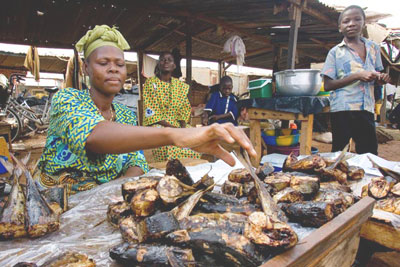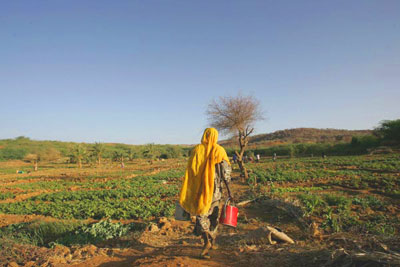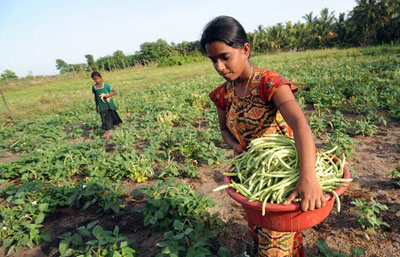Investing in rural women contributes to food security
Secretary-General’s message
for International Day of Rural Women
15 October 2010
( A | C | E | F | R | S ) |
Rural women form the backbone of the agricultural labour force across much of the developing world. Globally, more than a third of the female workforce is engaged in agriculture, while in regions like Sub-Saharan Africa and South Asia, more than 60 per cent of all female employment is in this sector.1 To afford food and other basic expenses, men and women in rural areas often diversify their income by combining multiple forms of employment. Women generally work as subsistence farmers, small-scale entrepreneurs, unpaid workers on family farms or casual wage labourers – but they may take on all or a number of these activities at different times. Because in many developing countries women carry out a range of vital household and caring tasks, their overall working hours tend to be longer than men’s. In countries like Benin and Tanzania, for example, rural women work respectively 17.4 and 14 hours longer per week than their male counterparts.2
| |  |
| |
A woman selling fish in a downtown market in Ouagadougou, Burkina Faso. ©FAO/Alessandra Benedetti |
Providing women with better opportunities to grow their own crops for sale, undertake paid work in an agro-industry, or take on other paid activities in the rural sector is critical to increasing their bargaining power within the home and can legitimize their control over key material resources, such as land and credit. This is important because it elevates their status within families and communities, but also because women are more likely than men to invest their income on food and other basic needs for the household.3
Keshta is 31 years old and lives with her husband and six children in Al-Shokha, a rural area in south east Gaza Strip, which suffered severe damage during the Israeli military campaign Operation Cast Lead. To supply the family with a much-needed income, a project sponsored by the Food and Agricultural Organization (FAO) provided her with one male and five female rabbits, enough fodder for 3 months and training on rabbit maintenance. Thanks to this initiative, Keshta and her family now benefit directly from the sale of rabbits and she is able to reinvest part of her income on fodder and medicines to keep on breeding.
"The training conducted before receiving the rabbit unit developed my capacity and enabled me to use the vaccines and veterinary medicines easily,” she said. Protein from rabbit consumption has also enriched her children’s diet and boosted the family’s resilience to food insecurity.
"The project gave me a great opportunity to be a contributing member of my family. The family income has increased. We are a poor and large family and my husband has been unemployed for a long time; we have family expenses so we need resources to meet these," she added.
 |
| | A woman farmer in Niger carrying watering cans to irrigate crops. ©FAO/Giulio Napolitano |
|
But many rural women continue to face obstacles that undermine their opportunities for success, such as lack of public and social infrastructure, unequal access to credit, technical equipment and other important resources, like land and water. In Burkina Faso, Kenya, Tanzania and Zambia, for example, studies have shown that allocating land, labour, capital and fertilizer equally among men and women could increase agricultural production by between 10 and 20 percent.4
“Investing in better roads, transportation, electricity, water supply, childcare and health services is also key to reducing the time women spend on day-to-day unpaid work and can give them an opportunity to seize productive employment outside of the home,” says Eve Crowley, FAO’s Principal Advisor in the Gender, Equity and Rural Employment Division. This is particularly relevant in situations of environmental degradation or when the effects of HIV and AIDS and other diseases increase women’s household responsibilities and economic pressures, as they look after sick relatives and orphaned children.
Education, skills development and technical training are likewise central to rural employment. They can help women-led businesses to expand their networks, to identify more lucrative markets with potential for employment and connect them to better growth opportunities. Female wage workers who are given equal opportunities in education and training are also more likely to compete favorably with men for quality jobs5:
“Women make up 20-30 percent of agricultural wage workers6 and often predominate in high-value industries for export - such as fresh fruits, vegetables and flowers. Although these non-traditional sectors of agriculture can present women with unprecedented income opportunities, we often find that women are hired on temporary or casual contracts to perform labour-intensive, manual tasks. They are given limited opportunities to acquire new skills and, overall, higher-level positions continue to be captured by men,” says Crowley.
| |  |
| |
A woman farmer in Sri Lanka harvesting beans. ©FAO/Ishara Kodikara |
FAO in collaboration with the International Labour Organization (ILO) is working to identify new trends in rural labour markets and to ensure that gender-sensitive measures are integrated in the policy guidance that both agencies give at country level.
“To fight hunger in the world we will need the energies of both men and women. Worldwide, rural women are key to food security: they make up a significant share of agricultural producers and play a crucial role in feeding their families and their nations,” she affirms.
“Recognizing women’s contribution and taking into account their needs at all levels – in countries, in institutions and in policy – is therefore essential to increasing their productive capacities and to unleashing the greater contribution they can provide.”
Author: Ilaria Perlini, Gender, Equity and Rural Employment Division (ESW), Food and Agriculture Organization of the United Nations (FAO)
|
 A woman farmer in Cambodia tilling a rice paddy for the planting season
A woman farmer in Cambodia tilling a rice paddy for the planting season

